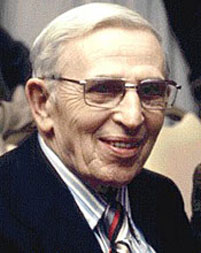 Clifford D. Simak’s (“Simak,” pronounced with the short “i”) “Junkyard” was published in the May, 1953 issue of Galaxy Science Fiction and aired February 22, 1956 on X Minus One. It is one of the more intriguing science-fiction scenarios we’ve run across recently from our initial Old Time Radio perusals. It finds a spaceship crew exploring a planet they’ve spied from afar, and what looks to them to be an inexplicable pile of junk on the planet’s surface. They land to investigate. One by one the crew begins to exhibit memory loss, and soon can’t remember how to start the ship’s engines for take-off. The mystery becomes curiouser and curiouser, taking several unanticipated twists. Will the crew not only discover what is causing their memory loss, but be able to do so before they forget what they are attempting? One mystery leads to another in this cleverly imagined story.
Clifford D. Simak’s (“Simak,” pronounced with the short “i”) “Junkyard” was published in the May, 1953 issue of Galaxy Science Fiction and aired February 22, 1956 on X Minus One. It is one of the more intriguing science-fiction scenarios we’ve run across recently from our initial Old Time Radio perusals. It finds a spaceship crew exploring a planet they’ve spied from afar, and what looks to them to be an inexplicable pile of junk on the planet’s surface. They land to investigate. One by one the crew begins to exhibit memory loss, and soon can’t remember how to start the ship’s engines for take-off. The mystery becomes curiouser and curiouser, taking several unanticipated twists. Will the crew not only discover what is causing their memory loss, but be able to do so before they forget what they are attempting? One mystery leads to another in this cleverly imagined story.
Clifford D. Simak (1904-1988) was one of the science-fiction family’s most beloved members. Longtime friends of Gordon R. Dickson and Poul Anderson, all friends from their original Minneapolis, Minnesota origins, he was honored as SFWA’s third Grand Master in 1977 (for the year 1976, preceded only by Robert A. Heinlein and Jack Williamson, respectively), won the International Fantasy Award for his classic 1953 fix-up classic novel City, and was given the Bram Stoker Lifetime Achievement Award in 1988. His other awards include three Hugo trophies (“The Big Front Yard”–1959, Way Station–1964, and “Grotto of the Dancing Deer”–1981), and a Nebula Award, also for “Grotto of the Dancing Deer” in 1981. Cliff Simak was interviewed in Tangent #2, for May of 1975, in the magazine’s original incarnation before it became an all short-fiction review magazine in July/August of 1993. This classic interview will be reprinted here for the first time in 2010.
While Cliff’s 1953 Galaxy story “Junkyard” was thought worthy of a radio dramatization, it was up against some monumental –to say the least– print stories that year, including some memorable, oft-reprinted classics, such as Damon Knight’s “Four in One” and Theodore Sturgeon’s “Saucer of Loneliness” (both from the February, 1953, Galaxy), “The Liberation of Earth” by William Tenn (Future Science Fiction, May), Ward Moore’s iconic “Lot” from The Magazine of Fantasy & Science Fiction (May), (Sir) Arthur C. Clarke’s “The Nine Billion Names of God” from Star Science Fiction Stories (the very first original SF anthology series, edited by Frederik Pohl) and Jerome Bixby’s “It’s a Good Life” from Star Science Fiction Stories 2.
While X Minus One was in full stride in February of 1956 following its debut in April of 1955, and its eager audience was growing steadily, SF fans in 1956 (as opposed to the print stories above, published in 1953) were still reading their favorite magazines, and stories such as Alan E. Nourse’s “Brightside Crossing” (Galaxy, January), Algis Budrys’ “Silent Brother” (Astounding Science Fiction, February), and James Blish’s “A Work of Art” (Science Fiction Stories, July).
1956 was also the year that Marilyn Monroe (buxom, blonde, talented, movie sex goddess as she was, and [later] mistress to Bobby Kennedy {Attorney General of the United States and brother to the President}–first–and then President John F. Kennedy, respectively,) married famed playwright Arthur Miller. 1956 also saw the soap operas As the World Turns and The Edge of Night debut on tv, and I Love Lucy held its position as the number one show on television.
Herewith, Clifford D. Simak’s inspired take on a traditional SF trope, “Junkyard.”
Play Time: 27:51